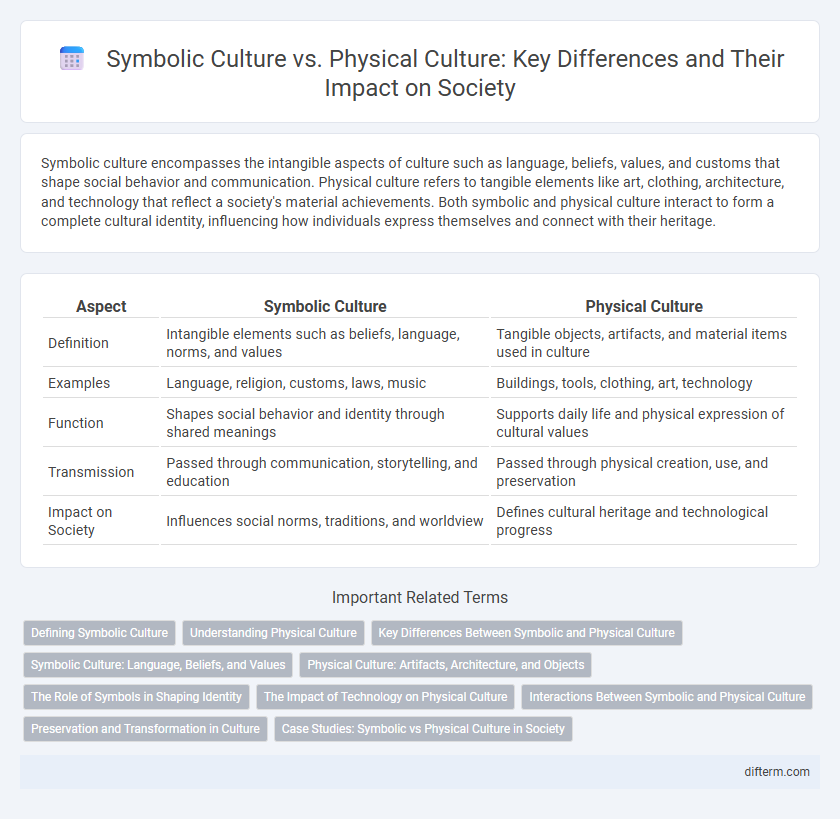Symbolic culture encompasses the intangible aspects of culture such as language, beliefs, values, and customs that shape social behavior and communication. Physical culture refers to tangible elements like art, clothing, architecture, and technology that reflect a society's material achievements. Both symbolic and physical culture interact to form a complete cultural identity, influencing how individuals express themselves and connect with their heritage.
Table of Comparison
| Aspect | Symbolic Culture | Physical Culture |
|---|---|---|
| Definition | Intangible elements such as beliefs, language, norms, and values | Tangible objects, artifacts, and material items used in culture |
| Examples | Language, religion, customs, laws, music | Buildings, tools, clothing, art, technology |
| Function | Shapes social behavior and identity through shared meanings | Supports daily life and physical expression of cultural values |
| Transmission | Passed through communication, storytelling, and education | Passed through physical creation, use, and preservation |
| Impact on Society | Influences social norms, traditions, and worldview | Defines cultural heritage and technological progress |
Defining Symbolic Culture
Symbolic culture encompasses the intangible elements of culture such as beliefs, values, language, and customs that shape a society's identity and social behavior. It represents the shared symbols and meanings that individuals use to communicate and interpret their world, distinguishing it from physical culture, which includes tangible artifacts and material objects. Defining symbolic culture involves understanding how collective meanings and social norms influence cultural cohesion and individual interactions.
Understanding Physical Culture
Physical culture encompasses tangible aspects of society such as artifacts, architecture, clothing, and technology that reflect human creativity and adaptation. It provides insight into a community's way of life, historical development, and social organization by examining material objects and their uses. Unlike symbolic culture, which includes language, beliefs, and values, physical culture is anchored in concrete items that influence and shape daily interactions and cultural identity.
Key Differences Between Symbolic and Physical Culture
Symbolic culture encompasses the intangible elements of culture such as language, beliefs, values, and norms, which shape social behavior and collective identity. Physical culture refers to tangible artifacts, technology, and material objects produced and used by a society, reflecting its history and environment. The key difference lies in symbolic culture's focus on meaning and communication, while physical culture emphasizes concrete, physical expressions of human activity.
Symbolic Culture: Language, Beliefs, and Values
Symbolic culture encompasses intangible elements such as language, beliefs, and values that shape social interactions and collective identity. Language functions as the primary medium for transmitting cultural meaning and preserving traditions across generations. Beliefs and values guide behavior, establish norms, and influence societal structures within symbolic cultural systems.
Physical Culture: Artifacts, Architecture, and Objects
Physical culture encompasses tangible artifacts, architecture, and objects that embody the material aspects of society's heritage and daily life. These elements include tools, artworks, buildings, and monuments that reflect cultural values, technological advancements, and historical contexts. Architects and archaeologists study these physical manifestations to interpret social structures and cultural evolution over time.
The Role of Symbols in Shaping Identity
Symbols in symbolic culture serve as powerful tools for expressing values, beliefs, and social identities, creating shared meanings that unify communities. Physical culture, including artifacts and tangible objects, embodies these symbols but relies on symbolic interpretation to convey significance beyond their material form. The interplay between symbols and physical manifestations shapes collective identity by linking abstract cultural concepts to concrete experiences.
The Impact of Technology on Physical Culture
Technology has revolutionized physical culture by introducing advanced tools and equipment that enhance athletic performance and physical training methods. Innovations such as wearable fitness trackers, virtual reality workout environments, and biomechanical analysis devices enable precise monitoring and improvement of physical activities. These technological advancements have reshaped exercise routines, sports strategies, and overall health practices within physical culture.
Interactions Between Symbolic and Physical Culture
Symbolic culture, comprising language, beliefs, and values, shapes the meanings and norms that guide physical culture, such as artifacts, technology, and institutions. The interaction between symbolic and physical culture is evident when cultural symbols influence the creation and use of physical objects, reinforcing social identity and collective memory. Changes in symbolic culture often drive innovations in physical culture, while modifications in physical culture can feedback to reshape symbolic meanings within a society.
Preservation and Transformation in Culture
Symbolic culture, encompassing language, beliefs, and values, is preserved through traditions, rituals, and education, enabling societies to maintain collective identity despite generational change. Physical culture, including artifacts, architecture, and technology, transforms as new materials and innovations emerge, reflecting adaptability and societal evolution. Both forms interact dynamically, where symbolic meanings influence the conservation of physical objects, and physical culture acts as a tangible record of symbolic heritage.
Case Studies: Symbolic vs Physical Culture in Society
Case studies in society reveal distinct impacts of symbolic culture, such as language, beliefs, and rituals, versus physical culture, including tools, architecture, and technology. For example, indigenous tribes maintain cultural identity through symbolic elements like oral traditions and ceremonies, while urban societies exhibit physical culture through infrastructure and technological advancements. These cases highlight how symbolic culture shapes social norms and values, whereas physical culture reflects practical adaptations to environmental and societal needs.
Symbolic Culture vs Physical Culture Infographic

 difterm.com
difterm.com